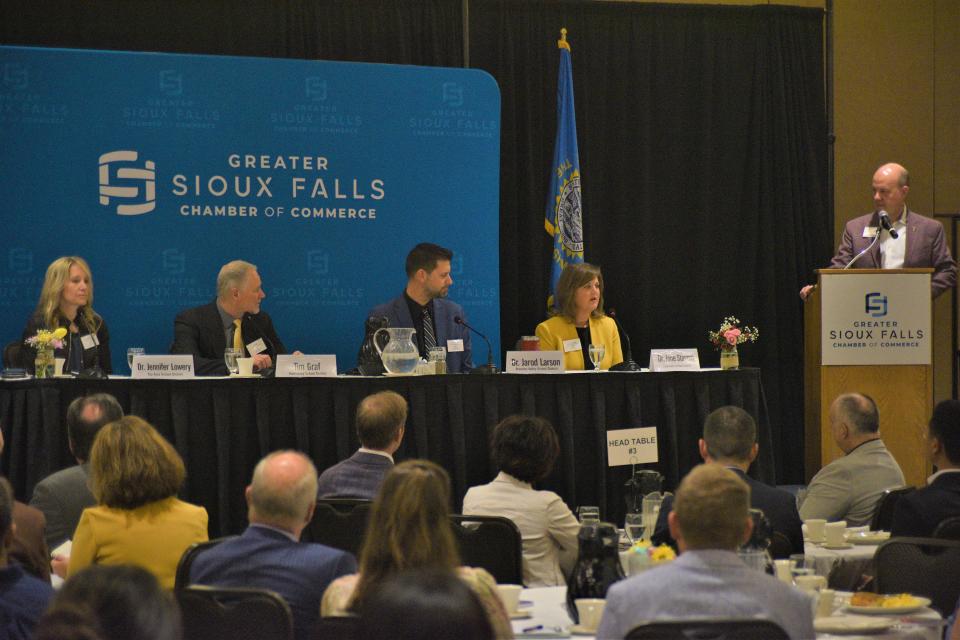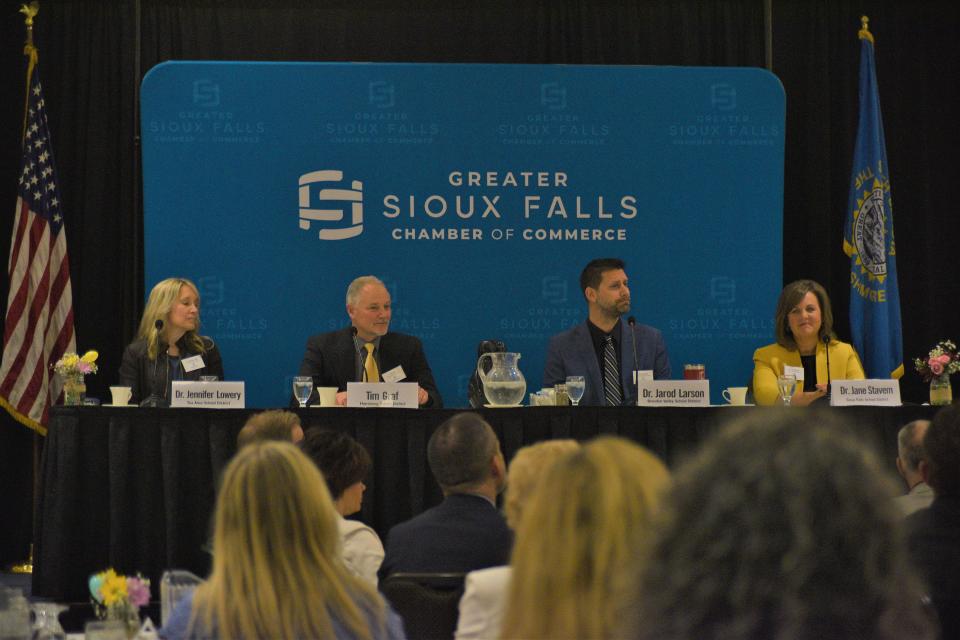Sioux Falls-area superintendents talk social studies standards, school safety and growth
Attendance and vaping.
That’s what keeps Sioux Falls School District Superintendent Jane Stavem up at night, as she told a group of dozens of business leaders during a superintendents’ talk Thursday morning in a Greater Sioux Falls Chamber of Commerce meeting.
Attendance is still seeing “a dent” from COVID-19, and children’s use of vape products or their addiction to vaping is on the rise across the nation, Stavem explained as part of the discussion of challenges facing South Dakota schools today.
“If I could find the person who invented (vaping) and started marketing it to children, I would throttle them,” Stavem said, adding even students in elementary school have gotten access to it through family members or by theft.
More: State K-12 report card shows absence is still an issue in South Dakota's schools
Stavem’s peers had some similar, but varied answers on the question posed by Vernon Brown, a moderator for the discussion and South Dakota State University vice president for external affairs

Brandon Valley School District Superintendent Jarod Larson said “top of mind” for him is the successful and on-time completion of his district’s high school construction project.
Meanwhile, mental health and behavior came to mind for Harrisburg School District Superintendent Tim Graf, he said.
“It’s amazing to me if you haven’t heard some of the things that we’re dealing with (and) our colleagues are dealing with all across the state and nation,” Graf said. “We’re not sure what’s causing it, but behaviors are off the charts. It’s really impacting our education workforce.”
With the increase of behavioral issues, teaching has “become a real challenge,” Graf added, making it harder to find substitute teachers and making the job more challenging for tenured educators.
More: How Sioux Falls area schools are experiencing, responding to COVID-19 learning loss in South Dakota
Attendance, mental health and students’ use of social media is what’s getting to the Tea Area School District Superintendent Jennifer Lowery, she said.
Here are four other big takeaways from the area's education leaders and other challenges mentioned during the talk, including takes on social studies standards, school growth, school safety and the recent politicization of education.
Social studies standards opposed by all four Sioux Falls-area superintendents
In Graf’s 25 years as a superintendent, there has never been a topic that everyone has been on the same page on, except for the state’s current proposed social studies standards. That doesn’t happen much in these positions, he said.
“Truly, we’ve not had a patron, we’ve not had a single teacher, we’ve not had a single parent (be a proponent) of the proposed standards,” Graf said. “It’s been easy in my situation to oppose them, and our board has been in opposition as well, which also makes it easier to oppose.”
There are rumors that the South Dakota Board of Education standards may push the current proposed draft set of standards back, because of edits and changes, but he said he also doesn’t know if those rumors have substance.

Lowery said she can’t live with the standards for her own children − a freshman, seventh grader and first grader −or the 2,300 students she’s in charge of as a superintendent.
“It’s just a very complex issue that’s not right for our kids,” she said. “If I’m the superintendent of schools, I have to be the instructional leader. When I look at it and I listen to my teachers and other educators, I’m not OK saying, ‘We’ll swallow it and move forward.’ If I don’t stand up for what I think is right for my own three children, I guess I’m not doing my job.”
Brown asked Stavem and Larson what the costs might be for larger districts in the state to implement the standards and find corresponding curriculum. Stavem said some of the practical matters of adopting the standards will be highly costly, and the standards come from a “totally different system of education” in a classical model.
More: Superintendents join call against South Dakota’s proposed social studies standards
“To overlay a portion of that into a traditional school schedule (with) the way that we arrange curriculum and orchestrate that scope and sequence all the way from elementary to high school, it doesn’t fit very well,” Stavem said.
For example, the district has its Spanish immersion program, and every student has a Chromebook, but some resources won’t be available in a Spanish or digital format to integrate the standards, Stavem said. And she doesn’t want staff members using time for that purpose, she added.
The last time a new instructional plan or implementation plan came through to adopt new social studies standards in the Sioux Falls School District, it cost about $3.5 million, Stavem said. Add in the cost of training for first grade teachers on content they’ve never seen, and it will be “pretty herculean,” Stavem said.
Larson said there’s an opportunity to take good things in the current 2015 set of standards, the 2021 workgroup’s draft of the standards and the current proposed set of standards that could be put together to make a great product for South Dakota’s students.
The fourth and final public hearing on the social studies standards is set for Monday in Pierre, during which the Board of Education Standards could choose to adopt or rework the current proposed social studies standards.
Where the school districts are growing in the Sioux Falls area
Each of the superintendents spoke about the growth occurring in their districts as the population in southeastern South Dakota and the Sioux Falls metropolitan area continues to increase.
In Brandon Valley, the high school is working on finishing up a $10 million, 35,000 square-foot addition of more than 20 classrooms, Larson said, all paid for by capital outlay cash with no additional tax burden on residents.

Harrisburg School District is growing so quickly that as many as 150 new high schoolers are added to the district’s enrollment count each year, Graf said. While Sioux Falls continues to grow without stopping, he said it’s a goal for the district to keep its small-town feel.
The district’s East Middle School is almost complete and will open in August. As many as 500 freshmen will be able to attend the freshman academy also opening in August on the west side of Cliff Avenue. Graf said the district could look at one day adding a third high school if growth continues as planned. Groundbreaking of an eighth elementary school will happen this week, too, Graf said.
More: Where are Sioux Falls-area schools set to grow in 2023? Here are the construction projects
Stavem said the Sioux Falls School District is looking at projects including the elementary school by George McGovern Middle School, adding onto GMMS for the after-school program, recent boundary changes affecting Renberg and Rosa Parks Elementary School and more. She mentioned Rosa Parks, Hayward and Discovery elementary schools are getting full while there’s still space at Lowell and Hawthorne elementary schools near the city’s center.
Tea Area School District grows at a rate of about 150 new students each year, Lowery said, and the goal is for the district to stay with one high school, two middle schools and multiple elementary schools. The district recently purchased land for the next elementary school, which will break ground in 2027, she said. Work to expand and renovate the high school is ongoing.
How Sioux Falls schools are keeping your kids safe
Another thing that keeps educators up at night is school safety, Lowery said, in response to an audience question about the topic. She said safety plans and procedures are kept confidential, but assured people that a safety team works on the safety issue.
More: Police respond to active shooter 'hoax' calls at South Dakota high schools
Schools utilize research-based best practices for school safety, Larson explained, adding the safest place for a student is behind a locked classroom door.
There’s also secured entrances, locked doors, school resource officers and a new staff member, Dave Osterquist, whose entire position is based on safety plans and procedures, Stavem explained for Sioux Falls schools. The district works on threat assessment and relies on folks to say something if they see something amiss.
More: Books, safety, busing and more: What you missed at Monday night's school board meeting
Graf noted schools also do a form of safety training, which instructs people to save themselves and to run, hide and fight an attacker as needed.

'Political extremism has vilified' some aspects of education
Some words used in a school district setting, such as “equity,” have become trigger words when they’re meant to be well-intentioned things, Stavem said.
“We’ve been vilified sometimes for using the word ‘equity,’ which for our district means having the same opportunities available at one high school as you do in another,” Stavem explained.
She said she’s received questions from constituents on the district’s use of “equity” as a term, even in budget line items like “equity travel,” which is money the district can use to help groups pay for transportation, for example, if they hadn’t fundraised enough money to make it to an event. One constituent had made it out to be a “very sinister-sounding thing,” she said.
“Unfortunately, we’ve taken some things and taken them to extremes,” Stavem said. “I think that’s one thing that school districts across the nation are suffering from right now, is that political extremism has vilified some things that are intended to do what we want in terms of, how do we treat kids? How do we honor differences in our community and our family, whether it be race, gender, any of those kinds of things?”
More: Sioux Falls schools, Legislature haven’t bowed to parents’ requests for book bans so far
The district welcomes every child who comes in, Stavem explained, and her colleagues Graf, Lowery and Larson echoed in the statements.
Schools should be non-political or politically neutral, Graf said, but added education is becoming more and more difficult to be moderate and neutral in today’s society.
If you walked into any of Tea’s schools, you would find hope and acceptance, Lowery said.
“It’s not as vicious as it’s being marketed or politicized,” Lowery said.
This article originally appeared on Sioux Falls Argus Leader: Sioux Falls-area superintendents discuss biggest issues facing schools

 money
money 